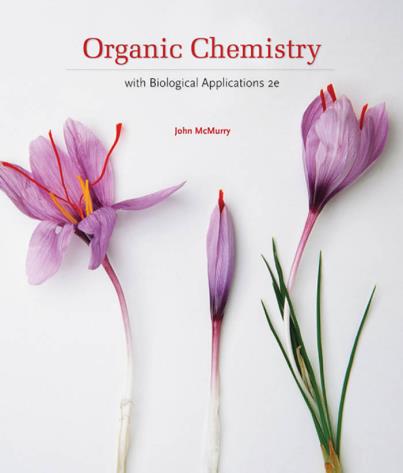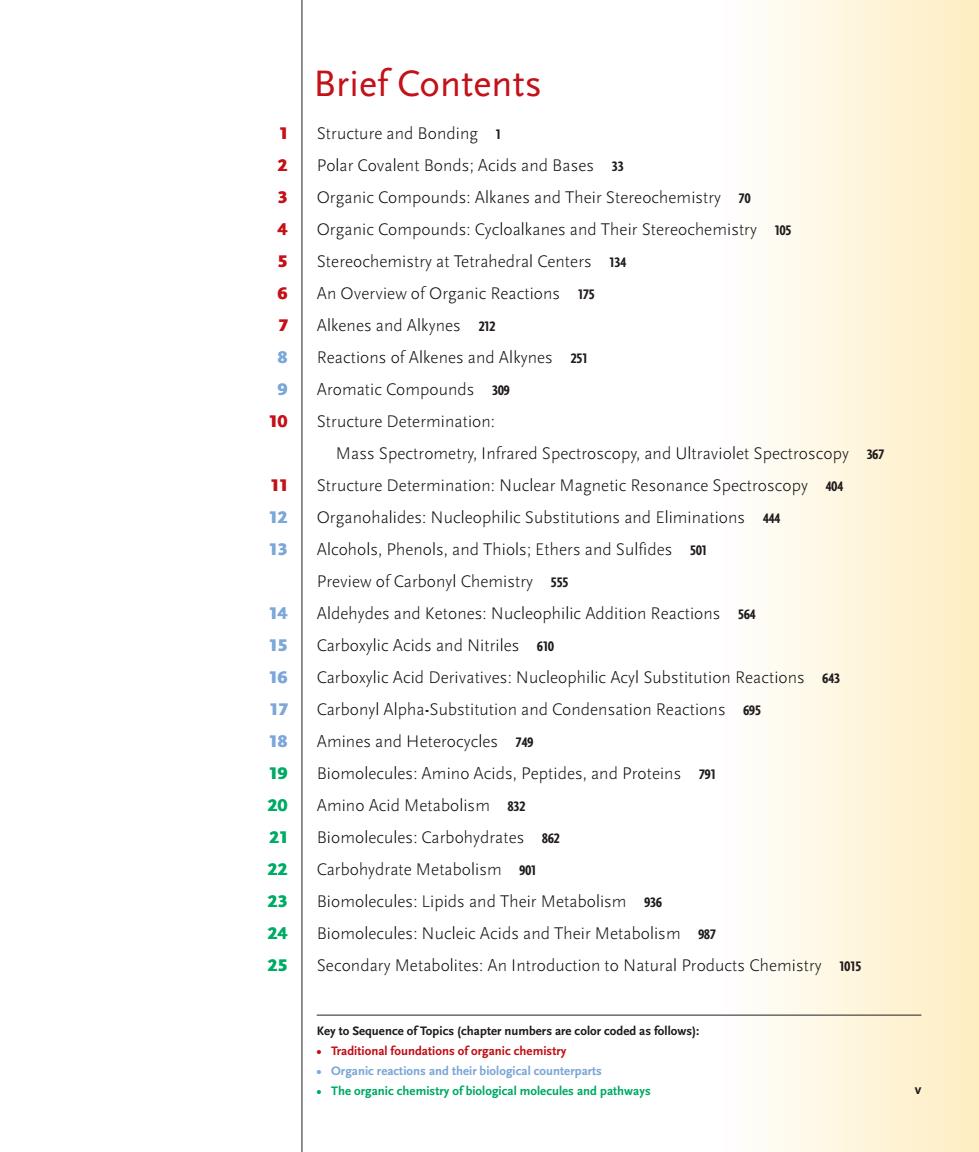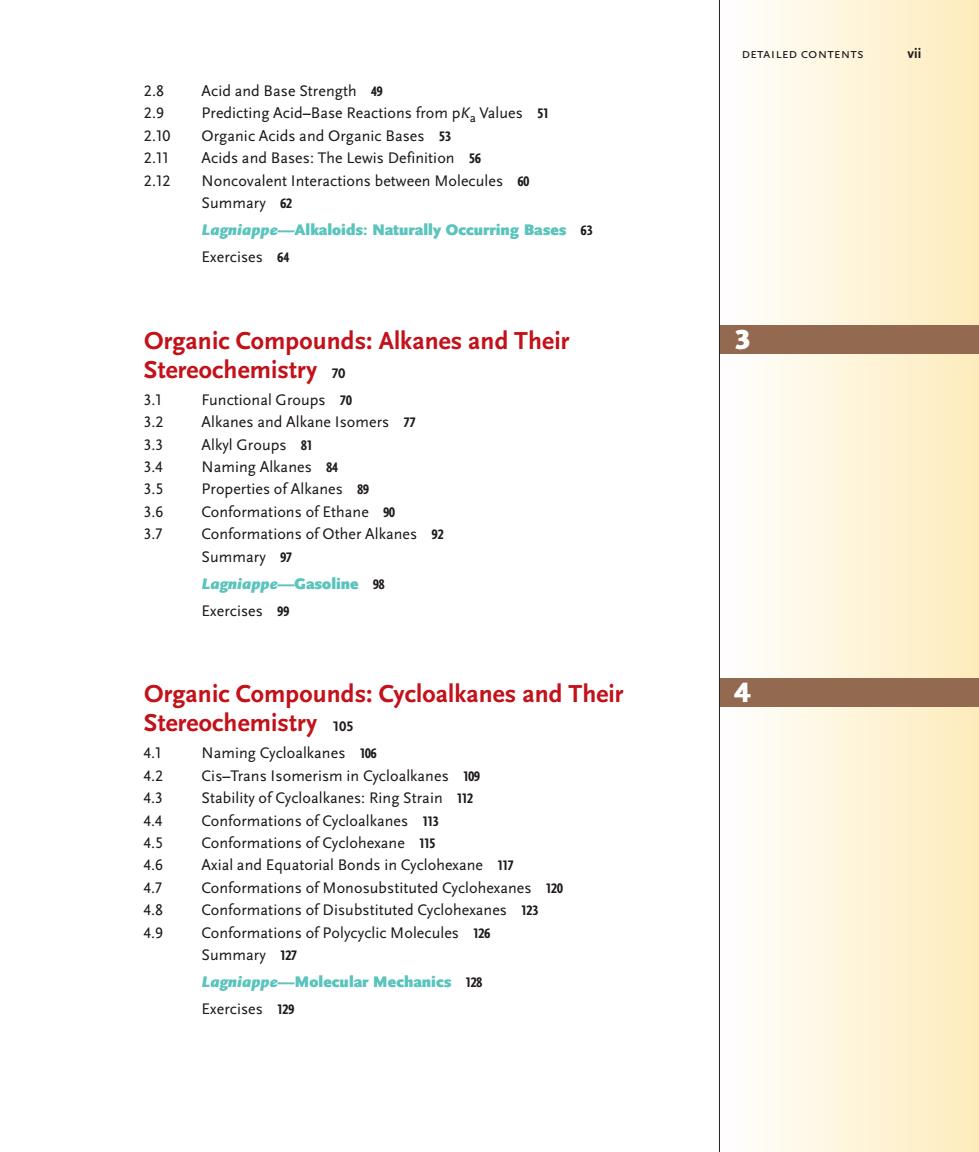
Organic Chemistry with Biological Applications 2e John McMury

Brief Contents Structure and Bonding 1 Polar Covalent Bonds:Acids and Bases 33 3 Organic Compounds:Alkanes and Their Stereochemistry 70 Organic Compounds:Cycloalkanes and Their Stereochemistry 105 Stereochemistry at Tetrahedral Centers 134 6 An Overview of Organic Reactions 17s 7 Alkenes and Alkynes 212 Reactions of Alkenes and Alkynes 251 9 Aromatic Compounds 309 10 Structure Determination: Mass Spectrometry,Infrared Spectroscopy,and Ultraviolet Spectroscopy 367 11 Structure Determination:Nuclear Magnetic Resonance Spectroscopy 404 12 Organohalides:Nucleophilic Substitutions and Eliminations 13 Alcohols,Phenols,and Thiols;Ethers and Sulfides 501 Preview of Carbonyl Chemistry ss5 14 Aldehydes and Ketones:Nucleophilic Addition Reactions 564 15 Carboxylic Acids and Nitriles 610 16 Carboxylic Acid Derivatives:Nucleophilic Acyl Substitution Reactions 64 17 Carbonyl Alpha-Substitution and Condensation Reactions 695 Amines and Heterocycles 749 19 Biomolecules:Amino Acids,Peptides,and Proteins79 20 Amino Acid Metabolism 832 21 Biomolecules:Carbohydrates 862 22 Carbohydrate Metabolism 901 Biomolecules:Lipids and Their Metabolism 936 24 Biomolecules:Nucleic Acids and Their Metabolism 98i Secondary Metabolites:An Introduction to Natural Products Chemistry 1015 Key t eof Topics (chapter as follows) oun ns of organic chemis stry Organic rea ons na th nterparts The organic chemistry of biological molecules and pathways
Brief Contents 1 Structure and Bonding 1 2 Polar Covalent Bonds; Acids and Bases 33 3 Organic Compounds: Alkanes and Their Stereochemistry 70 4 Organic Compounds: Cycloalkanes and Their Stereochemistry 105 5 Stereochemistry at Tetrahedral Centers 134 6 An Overview of Organic Reactions 175 7 Alkenes and Alkynes 212 8 Reactions of Alkenes and Alkynes 251 9 Aromatic Compounds 309 10 Structure Determination: Mass Spectrometry, Infrared Spectroscopy, and Ultraviolet Spectroscopy 367 11 Structure Determination: Nuclear Magnetic Resonance Spectroscopy 404 12 Organohalides: Nucleophilic Substitutions and Eliminations 444 13 Alcohols, Phenols, and Thiols; Ethers and Sulfides 501 Preview of Carbonyl Chemistry 555 14 Aldehydes and Ketones: Nucleophilic Addition Reactions 564 15 Carboxylic Acids and Nitriles 610 16 Carboxylic Acid Derivatives: Nucleophilic Acyl Substitution Reactions 643 17 Carbonyl Alpha-Substitution and Condensation Reactions 695 18 Amines and Heterocycles 749 19 Biomolecules: Amino Acids, Peptides, and Proteins 791 20 Amino Acid Metabolism 832 21 Biomolecules: Carbohydrates 862 22 Carbohydrate Metabolism 901 23 Biomolecules: Lipids and Their Metabolism 936 24 Biomolecules: Nucleic Acids and Their Metabolism 987 25 Secondary Metabolites: An Introduction to Natural Products Chemistry 1015 Key to Sequence of Topics (chapter numbers are color coded as follows): • Traditional foundations of organic chemistry • Organic reactions and their biological counterparts • The organic chemistry of biological molecules and pathways v 39144_ FM_i-xxiv.indd v 8/26/09 10:48:42 AM

Detailed Contents Structure and Bonding 1 1.1 Atomic Structure:The Nucleus 3 1.2 Atomic Structure:Orbitals4 1.3 Atomic Structure:Electron Configurations 6 14 Development of Chemical Bonding Theory 7 15 The Nature of Chemical Bonds:Valence e Bond Theory 10 1.6 spHybrid Orbitals and the Structure of Methane 12 1.7 sp3 Hybrid Orbitals and the Structure of Ethane 13 1.8 so2 Hybrid orbitals and the structure of Ethylene 14 1.9 sp Hybrid Orbitals and the Structure of Acetylene 17 11 Hybridization of Nitrogen,Oxygen,Phosphorus,and Sulfur 18 111 The Nature of Chemical Bonds:Molecular Orbital Theory 20 1.12 Drawing Chemical Structures 21 Summary 24 Lagniappe-Chemicals,Toxicity,and Risk 25 Working Problems 26 Exercises 26 Polar Covalent Bonds;Acids and Bases 3 2.1 Polar Covalent Bonds:Electronegativity 33 22 Polar Covalent Bonds:Dipole Moments 36 2.3 Formal Charges 38 24 Resonance 41 2.5 Rules for Resonance Forms 43 Drawing Resonance Forms 45 > Acids and Bases:The Bronsted-Lowry Definition 48 vi
vi Structure and Bonding 1 1.1 Atomic Structure: The Nucleus 3 1.2 Atomic Structure: Orbitals 4 1.3 Atomic Structure: Electron Configurations 6 1.4 Development of Chemical Bonding Theory 7 1.5 The Nature of Chemical Bonds: Valence Bond Theory 10 1.6 sp3 Hybrid Orbitals and the Structure of Methane 12 1.7 sp3 Hybrid Orbitals and the Structure of Ethane 13 1.8 sp2 Hybrid Orbitals and the Structure of Ethylene 14 1.9 sp Hybrid Orbitals and the Structure of Acetylene 17 1.10 Hybridization of Nitrogen, Oxygen, Phosphorus, and Sulfur 18 1.11 The Nature of Chemical Bonds: Molecular Orbital Theory 20 1.12 Drawing Chemical Structures 21 Summary 24 Lagniappe—Chemicals, Toxicity, and Risk 25 Working Problems 26 Exercises 26 Polar Covalent Bonds; Acids and Bases 33 2.1 Polar Covalent Bonds: Electronegativity 33 2.2 Polar Covalent Bonds: Dipole Moments 36 2.3 Formal Charges 38 2.4 Resonance 41 2.5 Rules for Resonance Forms 43 2.6 Drawing Resonance Forms 45 2.7 Acids and Bases: The Brønsted–Lowry Definition 48 1 2 Detailed Contents 39144_ FM_i-xxiv.indd vi 8/26/09 10:48:43 AM

DETAILED CONTENTS 2.8 Acid and Base Strength 49 2.9 Predicting Acid-Base Reactions from pK Values 51 2.10 Organic Acids and Organic Bases 53 2 Acids and Bases:The Lewis Definition 56 2.12 Noncovalent Interactions between Molecules 60 Summary 62 Lagniappe-Alkaloids:Naturally Occurring Bases 63 Exercises 64 Organic Compounds:Alkanes and Their Stereochemistry 70 3.1 Functional Groups 70 32 Alkanes and Alkane Isomers 77 33 Alkyl Groups 81 3.4 Naming Alkanes 84 3.5 Properties of alkanes 89 3.6 Conformations of Ethane 3 Conformations of Other Alkanes 92 Summary 97 Lagniappe-Gasoline 9 Exercises99 Organic Compounds:Cycloalkanes and Their Stereochemistry 10s 4.1 Naming Cycloalkanes 106 Cis-Trans Isomerism in Cycloalkanes 109 4.3 Stability of Cycloalkanes:Ring Strain 112 4.4 Conformations of Cycloalkanes 113 4.5 Conformations of Cyclohexane 115 Axial and Equatorial Bonds in Cyclohexane 17 4.7 Conformations of Monosubstituted Cyclohexanes 120 4.8 Conformations of Disubstituted Cyclohexanes 123 4.9 Conformations of Polycyclic Molecules 126 Summary 127 Lagniappe-Molecular Mechanics 128 Exercises 129
detailed contents vii 2.8 Acid and Base Strength 49 2.9 Predicting Acid–Base Reactions from pKa Values 51 2.10 Organic Acids and Organic Bases 53 2.11 Acids and Bases: The Lewis Definition 56 2.12 Noncovalent Interactions between Molecules 60 Summary 62 Lagniappe—Alkaloids: Naturally Occurring Bases 63 Exercises 64 Organic Compounds: Alkanes and Their Stereochemistry 70 3.1 Functional Groups 70 3.2 Alkanes and Alkane Isomers 77 3.3 Alkyl Groups 81 3.4 Naming Alkanes 84 3.5 Properties of Alkanes 89 3.6 Conformations of Ethane 90 3.7 Conformations of Other Alkanes 92 Summary 97 Lagniappe—Gasoline 98 Exercises 99 Organic Compounds: Cycloalkanes and Their Stereochemistry 105 4.1 Naming Cycloalkanes 106 4.2 Cis–Trans Isomerism in Cycloalkanes 109 4.3 Stability of Cycloalkanes: Ring Strain 112 4.4 Conformations of Cycloalkanes 113 4.5 Conformations of Cyclohexane 115 4.6 Axial and Equatorial Bonds in Cyclohexane 117 4.7 Conformations of Monosubstituted Cyclohexanes 120 4.8 Conformations of Disubstituted Cyclohexanes 123 4.9 Conformations of Polycyclic Molecules 126 Summary 127 Lagniappe—Molecular Mechanics 128 Exercises 129 3 4 39144_ FM_i-xxiv.indd vii 8/26/09 10:48:49 AM

DETAILED CONTENTS 5 Stereochemistry at Tetrahedral Centers 134 5.1 Enantiomers and the Tetrahedral Carbon 135 52 The Reason for Handedness in Molecules:Chirality 136 Optical Activity140 5.4 Pasteur's Discovery of Enantiomers 142 55 Sequence Rules for Specifying Configuration 143 5.6 Diastereomers 149 57 Meso Compounds 151 5.8 Racemic Mixtures and the Resolution of Enantiomers 154 5.9 A Review of Isomerism 156 5.10 Chirality at Nitrogen,Phosphorus,and Sulfur 158 5.11 Prochirality 159 5.12 Chirality in Nature and Chiral Environments 162 Summary 164 Logniappe-Chiral Drugs 165 Exercises 166 6 An Overview of Organic Reactions 17s 6.1 Kinds of Organic Reactions 176 6.2 How Organic Reactions Occur:Mechanisms 17 6.3 Radical reactions 18 4 Polar Reactions 181 65 An Example of a Polar Reaction:Addition of H2O to Ethylene 186 6. Using Curved Arrows in Polar Reaction Mechanisms 189 67 Describing a Reaction:Equilibria,Rates,and Energy Changes19 6.8 Describing a Reaction:Bond Dissociation Energies19 6.9 Describing a Reaction:Energy Diagrams and Transition States 197 6.10 Describing a reaction:Intermediates 200 6.11 A Comparison between Biological Reactions and Laboratory Reactions 20 Summary 204 Lagniappe-Where Do Drugs Come From?20 Exercises 206 Alkenes and Alkynes 212 7.1 Calculating a Degree of Unsaturation 213 7.2 Naming Alkenes and Alkynes 216 7.3 Cis-Trans Isomerism in Alkenes 219 7.4 Alkene Stereochemistry and the E,Z Designation 221 7.5 Stability of Alkenes 223
viii detailed contents Stereochemistry at Tetrahedral Centers 134 5.1 Enantiomers and the Tetrahedral Carbon 135 5.2 The Reason for Handedness in Molecules: Chirality 136 5.3 Optical Activity 140 5.4 Pasteur’s Discovery of Enantiomers 142 5.5 Sequence Rules for Specifying Configuration 143 5.6 Diastereomers 149 5.7 Meso Compounds 151 5.8 Racemic Mixtures and the Resolution of Enantiomers 154 5.9 A Review of Isomerism 156 5.10 Chirality at Nitrogen, Phosphorus, and Sulfur 158 5.11 Prochirality 159 5.12 Chirality in Nature and Chiral Environments 162 Summary 164 Lagniappe—Chiral Drugs 165 Exercises 166 An Overview of Organic Reactions 175 6.1 Kinds of Organic Reactions 176 6.2 How Organic Reactions Occur: Mechanisms 177 6.3 Radical Reactions 178 6.4 Polar Reactions 181 6.5 An Example of a Polar Reaction: Addition of H2O to Ethylene 186 6.6 Using Curved Arrows in Polar Reaction Mechanisms 189 6.7 Describing a Reaction: Equilibria, Rates, and Energy Changes 192 6.8 Describing a Reaction: Bond Dissociation Energies 195 6.9 Describing a Reaction: Energy Diagrams and Transition States 197 6.10 Describing a Reaction: Intermediates 200 6.11 A Comparison between Biological Reactions and Laboratory Reactions 202 Summary 204 Lagniappe—Where Do Drugs Come From? 205 Exercises 206 Alkenes and Alkynes 212 7.1 Calculating a Degree of Unsaturation 213 7.2 Naming Alkenes and Alkynes 216 7.3 Cis–Trans Isomerism in Alkenes 219 7.4 Alkene Stereochemistry and the E,Z Designation 221 7.5 Stability of Alkenes 223 5 6 7 39144_ FM_i-xxiv.indd viii 8/26/09 10:48:49 AM